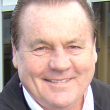Alan Jones
 Alan Jones’ first race was the 1975 Spanish Grand Prix at the fast Montjuïc circuit in his purchased Hesketh, and the weekend was to be one of the most tragic in Formula One history. After four races in F1 the team chose not to continue racing, but Jones did, as the race after his team disbanded he was named as an injury replacement for Rolf Stommelen on Graham Hill‘s racing team. He had a best finish of fifth at Nürburgring while there.
Alan Jones’ first race was the 1975 Spanish Grand Prix at the fast Montjuïc circuit in his purchased Hesketh, and the weekend was to be one of the most tragic in Formula One history. After four races in F1 the team chose not to continue racing, but Jones did, as the race after his team disbanded he was named as an injury replacement for Rolf Stommelen on Graham Hill‘s racing team. He had a best finish of fifth at Nürburgring while there.
Jones earned his first full-time F1 drive in 1976, in John Surtees‘ racing team. His car was mostly known for its infamous Durex sponsorship, but he managed several good finishes in it, a fourth in Japan being the best of them. He made the most of the opportunity and won at the Österreichring for his maiden victory, finishing seventh in the championship.
By 1977, he had already caught the attention of Frank Williams, who was looking to rebuild his F1 racing team. Williams Grand Prix had struggled for success in its first years and Jones was entrusted to give them their first taste of it. He helped put the team on the F1 map in 1979 using the Williams FW07, after winning four races in the span of five events near the end of the season. Jones finished third in the championship hunt that year, and it was the springboard to an excellent 1980 campaign.
Jones won seven races in 1980, although the Spanish Grand Prix was later removed from the championship and the Australian Grand Prix was a non-championship race, so only five counted towards the Championship. Throughout the season he had a car which consistently made the podium, and he achieved ten during the year. At the end of the season he had beaten Nelson Piquet by 13 points in the standings, becoming Australia‘s first World Champion since Sir Jack Brabham. He announced his retirement after the season, which he managed to cap off with a win in Las Vegas, but came out of retirement for a one-time drive with Arrows in 1983. Two more years later, Team Haas was created and Jones was the first driver for that outfit, and he would race a full season in 1986, his first in five years, but after a series of disappointing results he left F1 for good.
A competitive third placing at the 1988 Bathurst 1000 saw him signed up as full time number 2 driver to Tony Longhurst inhis Ford Sierra team. The team switched to BMWs in 1991, which saw the return of reliability at the cost of speed. A switch to Glenn Seton Racing mid-season in 1992 brought improved results and race wins and he finished runner up to his team leader Glenn Seton as their V8 Ford Falcons dominated the 1993 Australian Touring Car Championship. The team‘s dominance faded over the next few years. The 1995 Bathurst 1000 looked to be a high point with a memorable 1-2 finish for their two cars fading into just a second for the car Jones shared with Allan Grice. Jones took the major sponsor to form a new team with engineering brothers Ross and Jim Stone as partners, known commercially as Pack Leader Racing. Initially fast, the partnership was fading by 1997 and the Stones bought Jones out, rebadging the team as Stone Brothers Racing. Jones returned to race with Tony Longhurst‘s team again in 1998 by this time his form was fading. From 1999 onwards he no longer raced full-time, driving just the endurance races as a hired gun. His final race was with Dick Johnson Racing, driving into a seventh placed finish at the 2002 Bathurst 1000.
He became a commentator with Channel Nine as part of their F1 coverage in Australia in the late 1980s, a role which lasted over a decade. Jones has since become involved in the Australian franchise of the A1 Grand Prix as Team Director.